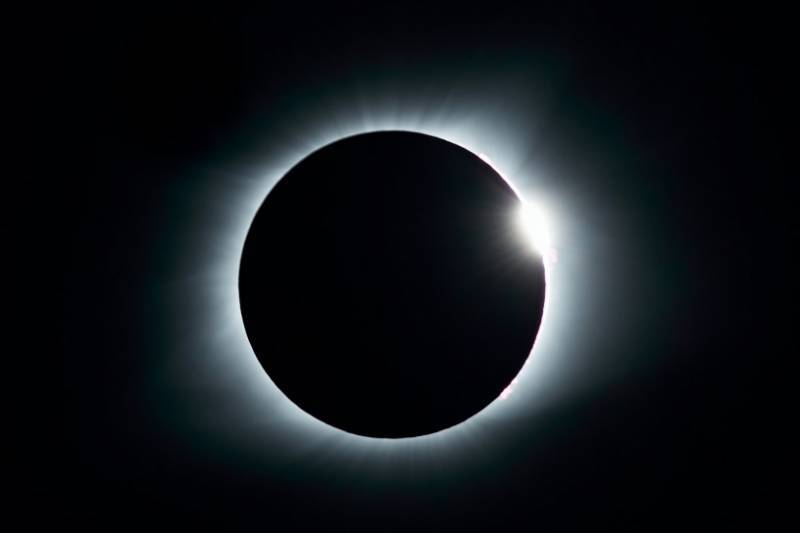if you’re looking for an amazing and rare experience, there’s a total eclipse happening in just about a month’s time (April 8, 2024) across much of the United States. If you just want to see it with your own eyes and experience “totality” (that is, when the Moon entirely blocks out the sun in the sky) a quick pair of solar glasses is all it takes!
But if you’re like me and love photography, maybe this will be a good chance to try and snag some rare photos of a total eclipse? I’m starting my preparations now!
Types of Eclipses
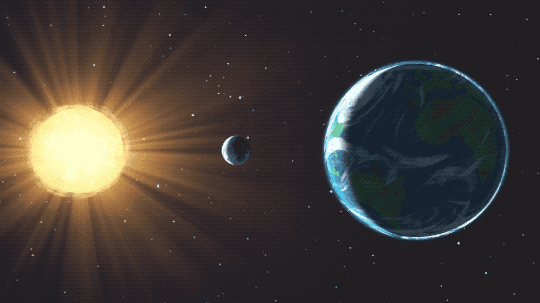
Solar Eclipses come in 3 (well, technically 4) types. They all occur in the same basic way; the Moon crosses between the Earth and the Sun, casting it’s shadow onto the Earth. For those down on Earth, the shadow will cause the day to darken. During Total eclipses, the Moon actually blocks out the entire sun and it becomes quite dark!
Annular Eclipse
The Moon orbits in an elliptical path around the Earth, and for part of the orbit it’s further away from the Earth (and appears smaller in the sky) than at other points. During an Annular eclipse, the Moon is near the furthest distance in it’s orbit. Because it’s further away and smaller in the sky, it doesn’t quite cover the entire sun; and as such, a “ring of fire” appears around the moon at it’s maximum coverage. These types of eclipses are really cool, and I was fortunate enough to see one with my wife during the October 14th, 2023 Eclipse!
Partial Eclipse
Sometimes the Earth, Sun, and Moon don’t perfectly line up, and when this happens only the crescent outline of the Moon will cover the Sun. This is what you will see during an Annular or Total eclipse if you’re not at the perfect spot on Earth to view. It’s still a sight worth seeing if you’re in the path. I saw one of these in 2017 (my first ever eclipse!). You still need safety glasses or a viewing tool though!
Total Eclipse
When the Moon is close enough to the Earth, the size of the Moon will completely block the sun. This is referred to as “totality”, and it will become almost as dark as dusk. When totality happens you can take off your glasses and see the corona of the sun around the Moon in the sky as a faint haze!
Hybrid Eclipse
Because of the curvature of the Earth, sometimes an eclipse can be annular in some spots, and total in other spots. Far out!
Viewing Safety
Before going any further, I need to mention this: do not look at the sun. You will seriously damage your eyes doing so. This gets even more dangerous during an eclipse. See, because the sun is more dim during an eclipse, your pupils open up, allowing more light than normal in. This means that particularly during an eclipse, you can seriously hurt or even blind yourself.
The danger in this from the Ultraviolet and Infrared light waves (not visible light waves) that the sun produces a whole lot of.
Seriously, don’t do it. Don’t even sneak a peek. It’s not worth losing your vision over. Instead if you want a direct view, invest in some extremely cheap (but ISO certified) solar glasses, such as these over at B&H. In fact, do the world a favor, buy a 10 pack, and hand them out at observations if you see other people without them.
Normal sunglasses will not suffice, do not look at the sun without ISO certified solar glasses. You can and will severely damage your eyes, have blurred or speckled vision afterwards (potentially for years), or suffer from permanent blindness or retina damage. Don’t do it. Don’t chance it.
If you don’t want to do that, you can make an indirect viewing tool out of a Shoebox, Aluminum Foil, and some Paper. In fact for my first eclipse, I made something similar to stop my co-workers from squinting at the sun together, lol.
My Game Plan
I’m lucky enough to live close to the Totality Path, and will be taking a short trip to set up along the outskirts of the path of totality. If my understanding is correct, this should give me about a minute and a half of totality.
First and foremost, I got a bunch of disposable glasses. I actually have more from last eclipse (Oct, 2023), but at that viewing I ended up handing out at least 4 pairs so I want to have even more this time to give away.
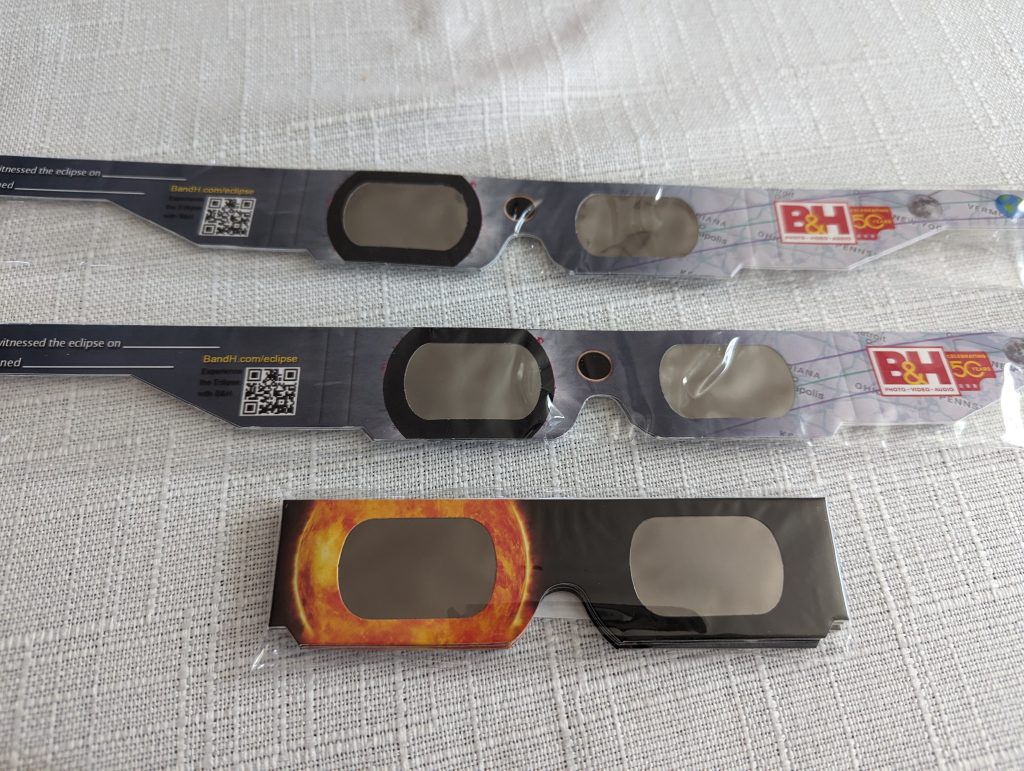
Since there will also be at least 3 people viewing, I was thinking of taking some old binoculars and creating an indirect viewing mount. Sky & Telescope Magazine had a great article in their latest edition, but they describe a similar method using a scope here.
Either way, if you’re creating a mount using a plastic telescope or binoculars, make sure they’re not ones you love too much; the heat of the sun can cause the plastic inside to melt and damage them. For this I’ll be using a pair of thrifted binoculars I got for $20. They’ve been loved and if they burn out in a firey blaze of glory, all the better.
Photographing the Eclipse
I might not get another chance at a total solar eclipse until 2044 (the next time there will be one in the U.S.!), so I want to try my best to make this count. I don’t do solar photography at all, so this is all a little mashed together.
My first plan is to use my trust Nikon D500 and a 200-500 f/5.6 lens to do a time lapse of the event. For this, I’ll be setting it onto my new EQ6-R Pro mount. This is the mount I use for astrophotography, and it’s awesome at tracking and features a Solar Tracking sidereal rate. It’s definitely overkill for the camera, but I’d rather it track consistently.
Additionally, I have a gifted Medium Format camera (Mamiya Q33) I managed to found the 250mm lens for. I have been messing around with bird photography with it, but I thought this could be a cool chance to try to take a solar image or two!
Celestron sells adaptable (and cheap) solar filters, and I picked up a pair at B&H also.
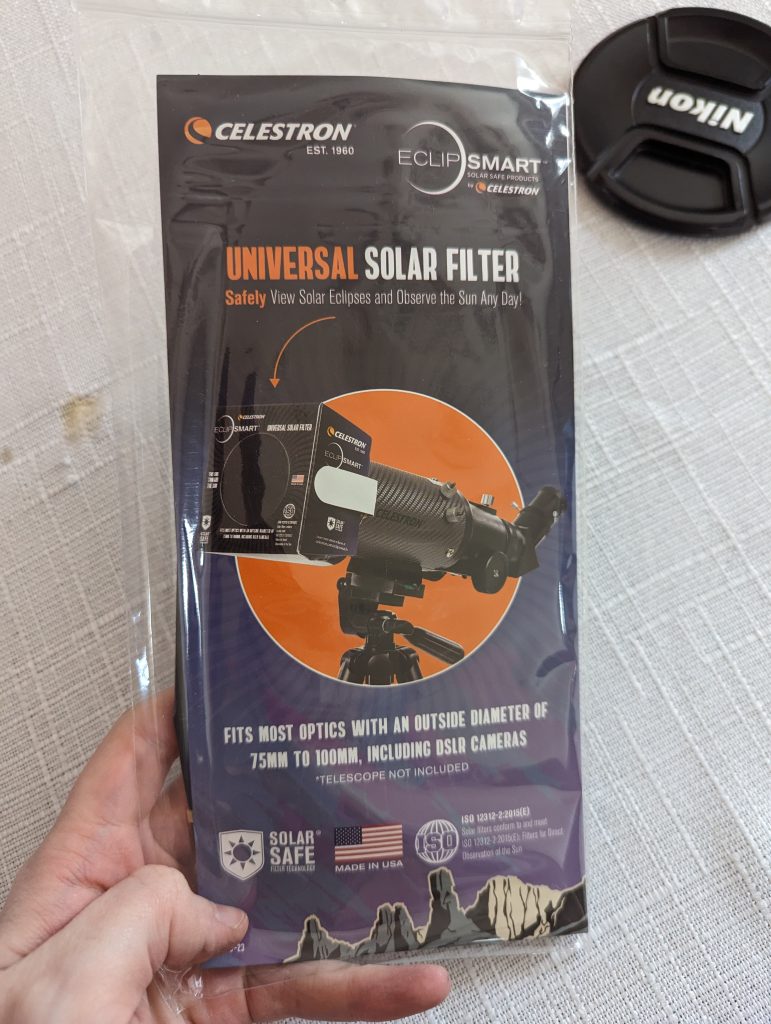
They fold together and use velcro and rubber bands; low tech solution, but ISO certified and at a great price point.
Since the Mamiya uses a double lens method, I do have to adjust it a little before photographing, but it fits great and I tested it through a window from my house to see if I could achieve focus.
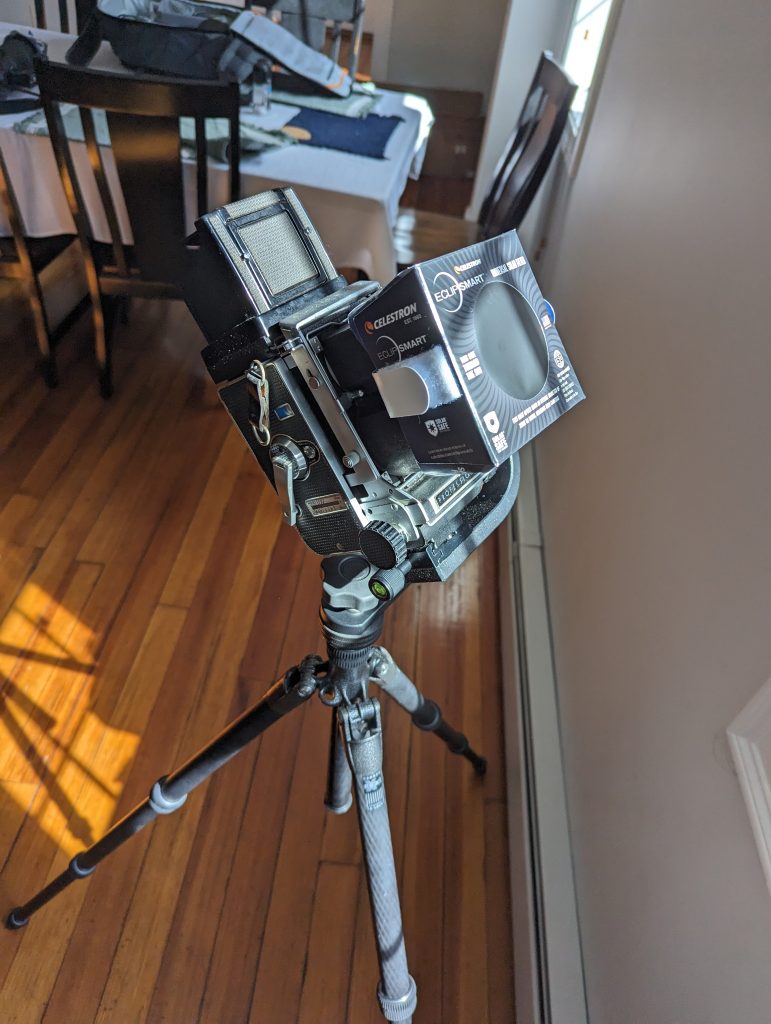
Pretty awesome! Even with the finder lens partially covered, the sun is obviously still bright enough to light itself significantly in the viewing disk. With the extra magnifier focus was actually fairly easy to achieve. This camera will be on a Alt-Az tripod.
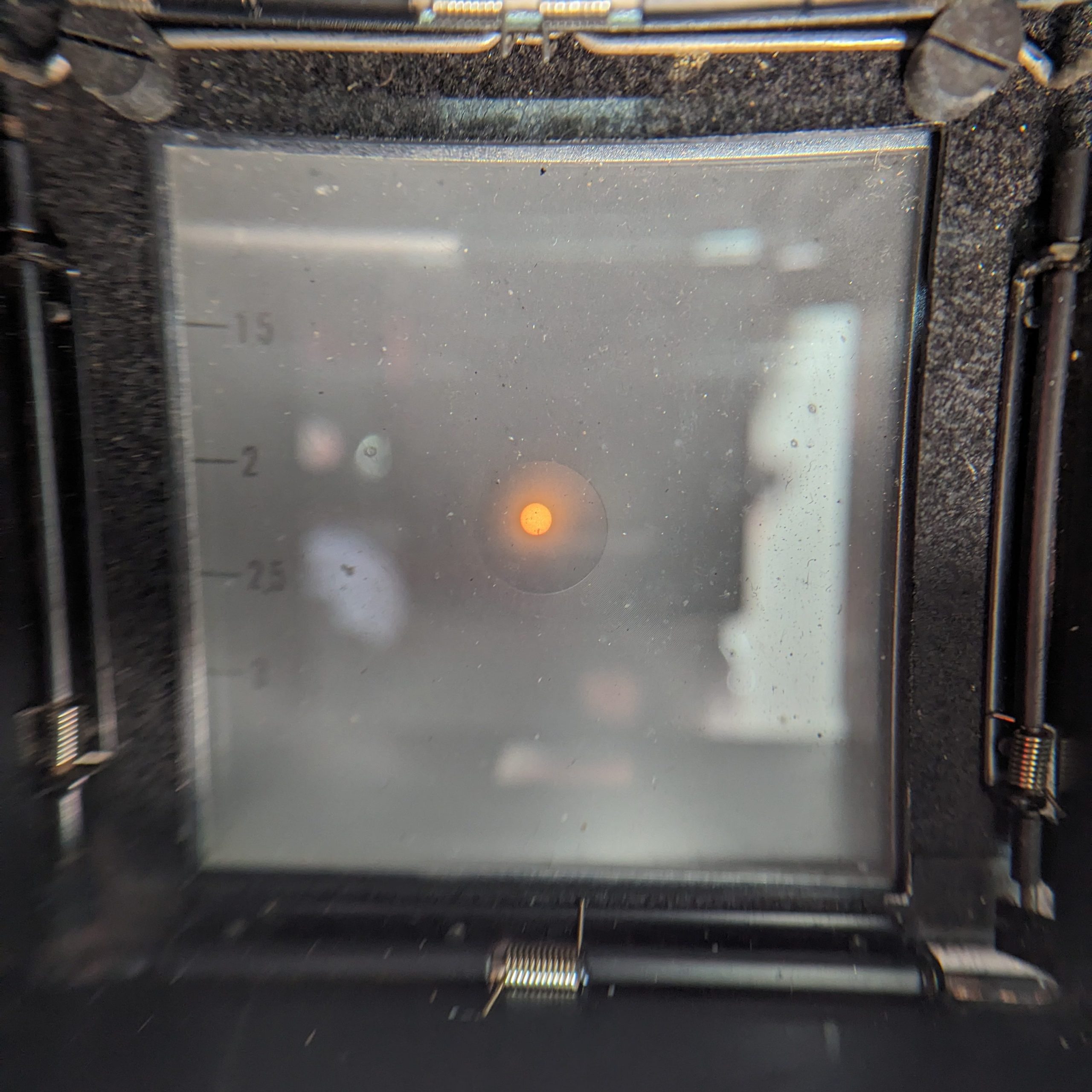
For the DSLR the fit was even better, though probably at the maximum size the Celestron filter could fit.
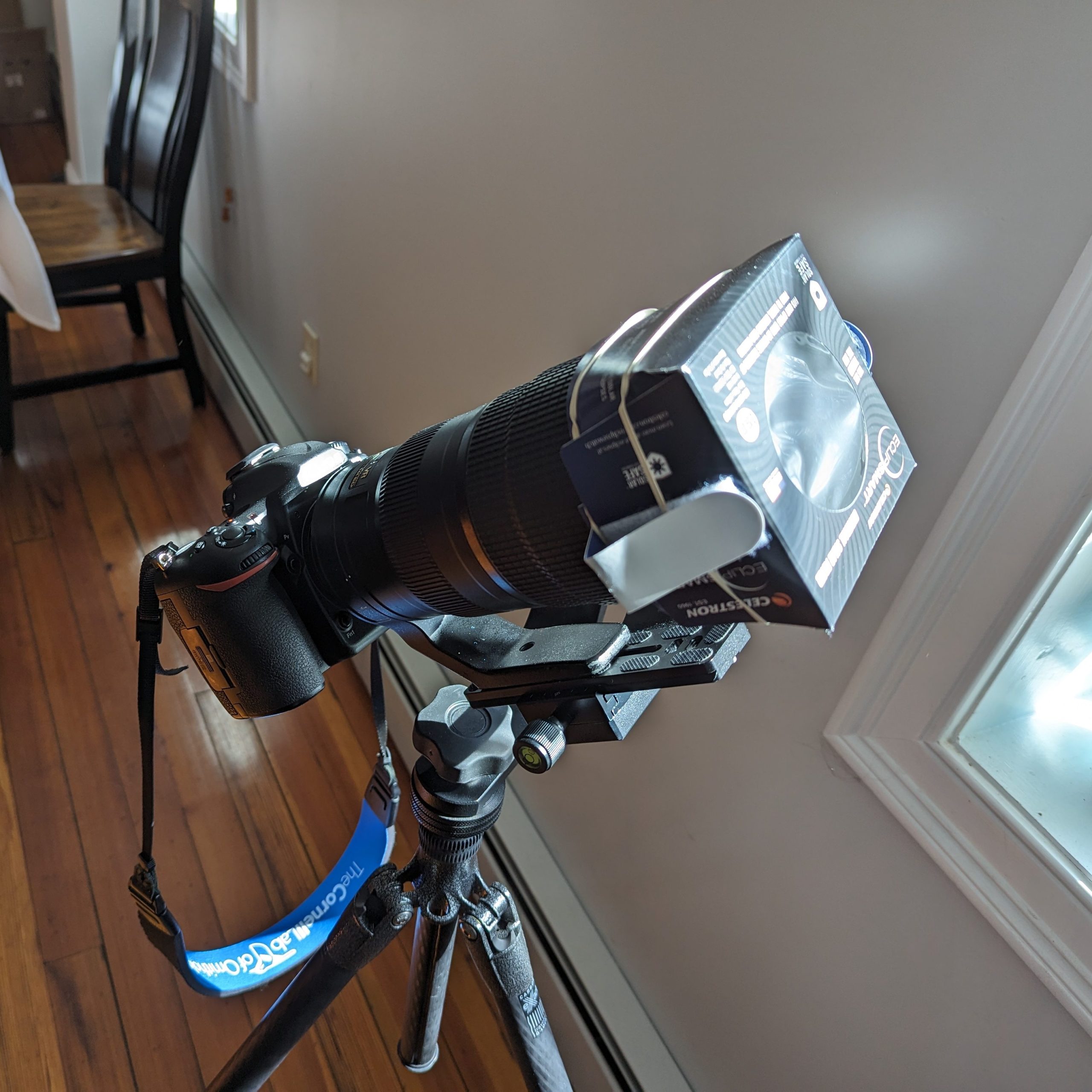
From here, lining up with the Sun is easy. I used Live View and a 10x magnifier to look at the outer edge and find focus. For testing purposes, I took 20 shots.
The Sun comes with three main challenges for photography, though my friends that do planetary photography will know some of them already.
The first challenge is atmospheric conditions. Because the Earth’s atmosphere is not static, it will distort images, meaning some photos will be more blurry than others. The classic way around this is “lucky” imaging (aka, take lots of pictures, and occasionally you’ll get lucky with a clear one). There’s also stacking options too, and mixing the two methods.
This seems to be even more prominent with the Sun, likely because it’s heating the atmosphere in front of it. So for the eclipse, I’ll have to take a large number of photographs even for the timelapse.
Good news, you don’t need long exposure for the Sun because it’s so bright! But during an eclipse, that brightness is dynamic, which brings us to challenge number two: Adjusting exposure. For this challenge, I’m actually planning to mostly “handle it in post”, as lightroom and smart settings let me even out a lot of the details. I plan to shoot around 400 ISO, and around 1/250s exposure at f/7.1. That seems like it will give me a good average brightness; not blown out in the early stages, and not too dim as we near totality.
Challenge number three is unique to an eclipse: No filter for totality. Because the Sun is completely blocked out, I’ll need to remove my solar filter during totality to photograph the corona. I’ll also need to adjust settings because the view will be so much darker. Alan Dyer has a good e-book on this (thanks BackyardAstro for posting a link!) and I’ll be using his recommendations as a reference.
Here’s a test “luck image” from today of the Sun
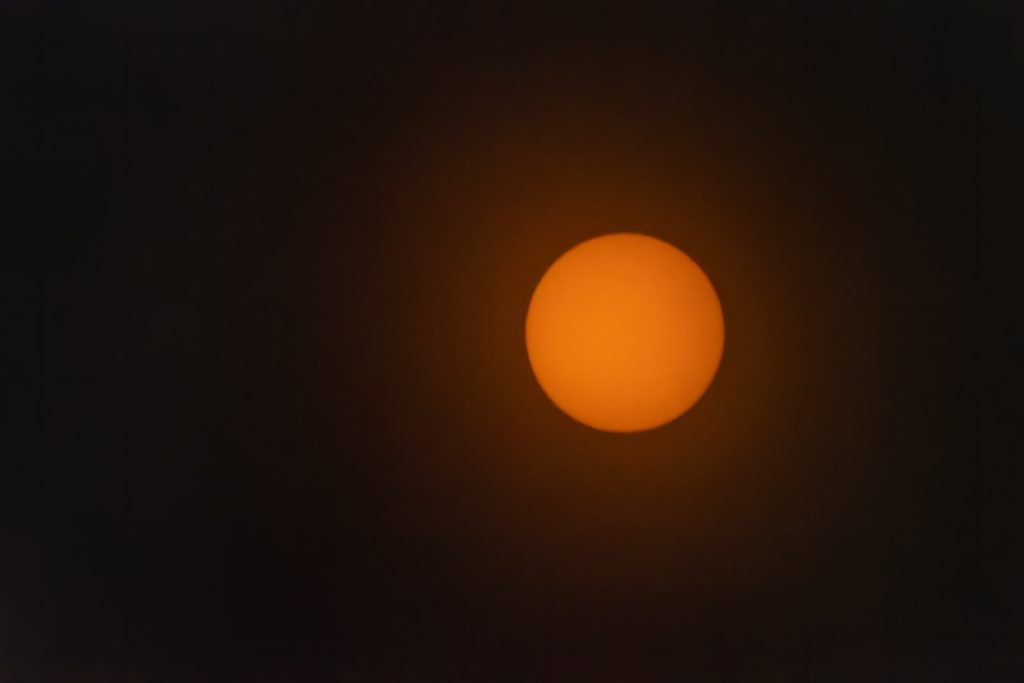
Last but not least, I’ll have my only Skywatcher Pro mount with a 8″ Reflector set up with a solar filter for close up viewing for those present. I’ve had this solar filter for almost two decades now, and it works great!
Don’t Miss The Moment
Photography and pre-planning aside, the most important thing to remember for this eclipse is to make sure you enjoy the moment. Totality is a rare event not many people get to experience. We won’t have another one crossing the U.S. for 20 years! It will only last a minute and a half for me and my group, so between the clicking of shutters and removing of glasses for the main moment, it’s important to remember to be in the moment and enjoy it 🙂
Thanks for reading!
